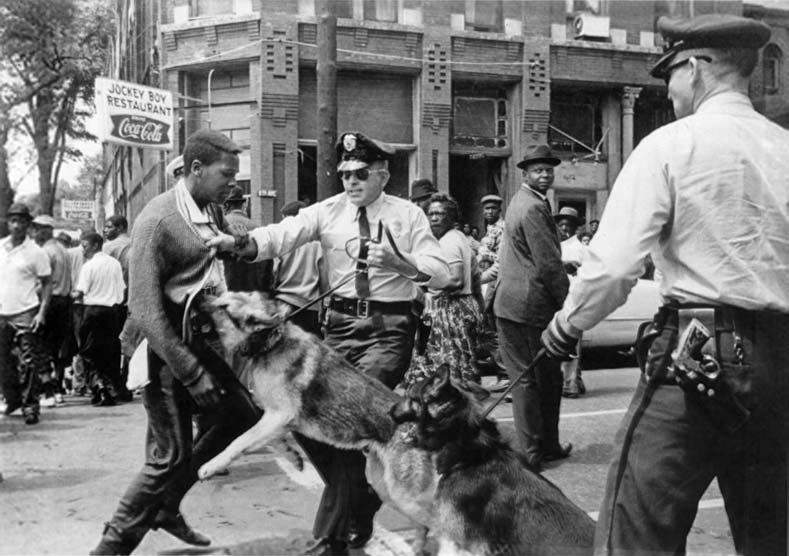This past week marked the 50th anniversary of the Children’s Crusade in Birmingham, Alabama. By many accounts it was the tipping point in generating national public support for the civil rights movement, and much of that effect is often attributed to the national news reports that showed Birmingham police officers using attack dogs and fire hoses on nonviolent protestors. Chief among the most famous of those images is Bill Hudson’s photograph of high school student Bill Gadsden being attacked by a police dog. It appeared the next day, May 4th, above the fold in the New York Times and has been reprinted perhaps more than any other image affiliated with the civil rights movement. The photograph was memorialized in a statue in Birmingham’s Kelly Ingram Park in 1993, fixing the meaning of the civil rights movement as a response to repressive state action.
There is much that could be said about this photograph, but perhaps most important is the way in which it puts the relationship between dominance and acquiescence on public display. Prior to the Boycott in Birmingham one could find photographs that visualized the ways in which white citizens sought to enforce the codes of social and racial hierarchy through verbal and physical intimidation, the most prominent example being the photograph of Hazel Barnes “barking” at Elizabeth Eckrich in the streets of Little Rock. But typically such images located the agency of such control in the hands of civil society, i.e., ordinary citizens. Here the agents of action are duly authorized police officers armed with guns and in control of highly trained attack dogs. And of course that marks a huge difference. Indeed, it should be of little surprise to anyone that the scene above, cast in the full light of day and executed by officers of the state, was characterized as a “legal lynching.”
To see the image through the haze of memory and framed by the contemporary consensus that state sponsored racial segregation was a profound injustice destined to be eliminated by a truly egalitarian society is in some ways to dull the effective, functional power of the image at its point of production and dissemination–however powerful it remains today. But imagine seeing the photograph in 1963 and in the context of reports made by the Commissioner of Public Safety, Eugene “Bull” O’Connor, that the protestors were a serious threat to public security.
The young man in the photograph does not appear to be a threat to anybody. Note in particular his somewhat passive stance. Despite being viciously attacked by a police dog his right hand rests at his side, while his left hand is on the police officers arm in a manner that seems either to be steadying himself or pushing the police officer away. We might imagine a much more defensive or even aggressive stance in response to such an attack, but here we have an almost textbook example of nonviolent resistance.
The lack of threat is manifest in other features of the image. Notice, in particular the countenance of the two police officers. One seems to be pulling the youth into the dog’s maw, not so much trying to subdue him as to hold him still while the dog attacks. The other police officer, with a handgun prominently displayed in its holster, heels his dog while he observes the scene before him. One might imagine that if the black youth were truly a threat, so much so as to warrant the use of a dog to attack him, that the second police officer would be more directly and actively engaged. Surely he would have his dog assisting in subduing the suspect, or that he would have pulled his gun. But nothing of the like happens. And the reason is manifest, for the action in the center of the screen is not about public safety. Rather it is a public spectacle put on display for the enjoyment of the second police officer (and who he represents) and for the intimidation of the black citizens in the background.
When Martin Luther King, Jr. was challenged by reticent and fearful black religious leaders in Birmingham with the question, why are you here, he responded, “I am in Birmingham because injustice is here.” Injustice can be a difficult concept to put into words, but once made palpably visible it is difficult to ignore. Sometimes we have to look closely to see it for what it is, sometimes it is there simply waiting to be seen.
Photo Credit: Bill Hudson/AP
